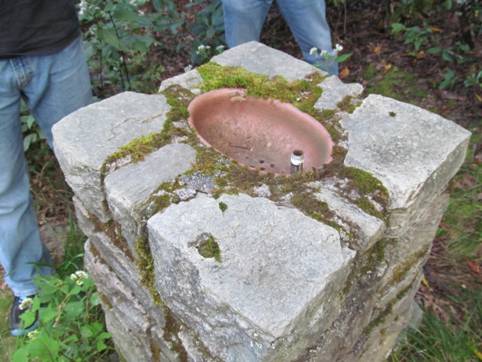A-B Tech Community College Civil Engineering Technology students may have their handiwork on the national stage after designing high-tech, rustic-looking drinking fountains on the Blue Ridge Parkway.
Five students from the Civil Engineering Technology project class — taught by Ken Cooper, civil engineering and surveying technology instructor — were given the opportunity to redesign the inner workings of the current fountains on the scenic route, many of which are no longer functional.
The Blue Ridge Parkway, known for its historic designed landscape, runs from the southern end of Skyline Drive at Rockfish Gap in Virginia’s Shenandoah National Park southwestward for 469 miles to the Oconaluftee River at the entrance to Great Smoky Mountains National Park in North Carolina. Construction began in September 1935 and took 52 years to complete. The route was carefully located and designed for recreational motoring to make the scenic vistas and mountain culture of the southern highlands accessible to the auto tourist. At one time there were about 100 historic water fountains on the route, making them a noticeable and important design feature of the Parkway.
Today only 20 to 25 of the original fountains are still functioning. The current water lines are cast iron and have issues with rusting. “Sometimes the pipes would burst. The design doesn’t allow for maintenance. Workers would have to deconstruct the entire fountain. It was such a problem that a lot of the fountains have been removed,” said Steven Kidd, cultural resources specialist/archeologist with the Blue Ridge Parkway.
“The National Park Service contacted Vernon Daugherty [dean of engineering and applied technology] to see if we would design a replacement fountain for the Blue Ridge Parkway,” Cooper said. A-B Tech now has a contract to supply building plans to the Parkway.
During the Fall 2012 semester, night cohort students Mike Goforth, Jay Hollingsworth, Landon Roberson, Jeremiah Ayers and Robert Brown designed a fountain that is easily maintainable. The newly designed water lines are freeze-resistant and rust-proof. If necessary, a fountain’s plumbing can be replaced without having to dismantle the rock housing.
Three of the students are now completing the project under Cooper’s guidance, and each of them brings personal strengths to the project. Roberson is the CAD expert, Goforth is the plumbing coordinator and Hollingsworth is also a stonemason.
“This is a great opportunity for the students to be of service to the community. Another institution was offered the chance, but they didn’t have the skill set A-B Tech students have with their practical experience. The students got to work with real owners and get owner feedback on their project,” Cooper said. “They needed project management, cost estimating, concrete design, construction materials and steel design knowledge — all which are taught in the Civil Engineering Technology program.”
“The A-B Tech students came up with an innovative way to tackle the problem with modern materials and maintain the historic look. The end result will be design plans that will be biddable. It is a great partnership and it helps us out to accomplish our needs as well. We’ve been very pleased with the accomplishments with A-B Tech students and Ken. We have talent in our backyard and we were able to use that to overcome the challenges we are faced with,” Kidd said.




freeze resistant and rust proof? We call that plastic.